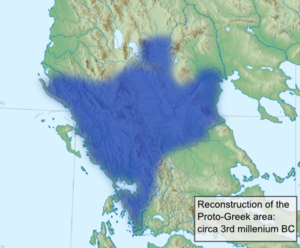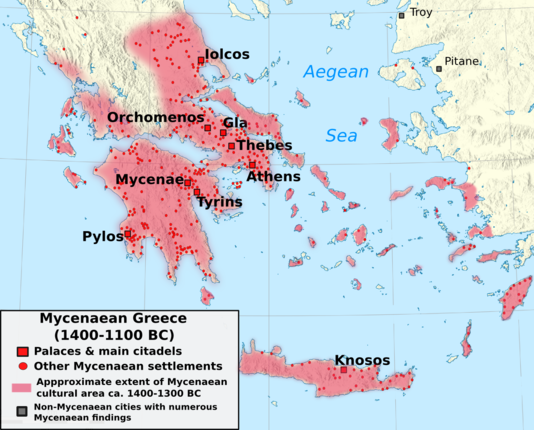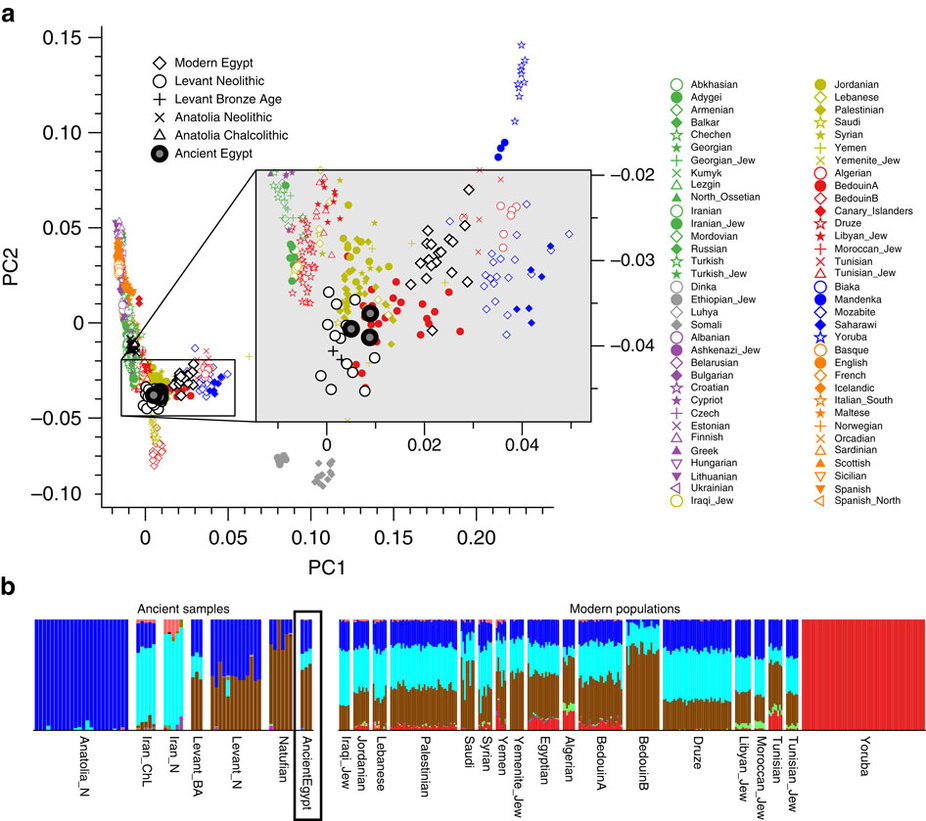I will list you few reasons why I think Akkadians did not come down from North.
1. There is no sign of anything Semitic during Sumerian period North of them. The only people known are 1. Hurrian like people and the Gutians.
2. Actually Akkadian text themselves attest East Semitic tribes settling from the West into Sumer which formed them.
3. Offshots of Akkadians aka Assyrians calling themselves "conquerers" of Subaru (North Mesopotamia) doesn't sound very local to me if you call yourself a conquerer.
4.No need for Semitic to evolve further East because Iran_N ancestry is already heavily involved in South_Levant_ eneolithic with yDNA J popping up next to typical proto Afro-Asiatic E1b.
So yes you are correct in arguing that some J people came down from the mountains in helping to form the Semites, but these guys actually came down and moved directly into the Levant. What I am trying to explain is you don't need to have Semites evolve or Akkadians come down from the North to explain the Iran_N ancestry in Semites, because it is already there in the South of Levant during late Neolithic.
Well, ultimately we seem to think more or less the same thing, that is, the same "architecture" of the formation of the Proto-Semitic people, only with some 600 or 700 kilometers of difference apart from each posited homeland. But I still have to say why I think the most likely scenario is that the earliest Proto-Semitic expansion came from the north/northwest of the Levant, almost bordering on Anatolia (yes, I concede that other Semitic-speaking areas may well have existed, but they weren't the main source of the Semitic-speaking Bronze Age expansion). There are several reasons for that, which I'll point out below:
1) The three other non-Akkadian kingdoms and ethnicities that are first attested in documents lived in the north, not in the South Levant: Eblaites in Northwestern Syria, Martu/Amurru in Central/Eastern Syria, the Assyrians referred as people originating in their main city of Assur, Northern Mesopotamia.
2) The Akkadians first gained political relevance with Sargon expanding their power from the Sumerian city of Kish, which was, coincidentally or not, one of the northernmost of the relevant Sumerian cities.
3) Before their wide expansion, Hurrians lived north of Mesopotamia and Levant, in the Armenian Highlands/Southeastern Anatolia, not in the place I'm talking of as a possible homeland of Proto-Semitic speakers. As for the Gutians, they were mountain tribes from the Zagros Mountains, not north nor northwest of Sumer, but actually northeast of it in the Zagros Mountains. None of those two peoples seem to have been indigenous to the region we are discussing here, which is the present north of Syria and Iraq near the upper reaches of the Tigris and Euphrates.
4) The location of Akkad, supposed to have been the capital of the Akkadians and their main city when they became a powerful ethnicity in Mesopotamia, wasn't found yet, but it is generally assumed to have been located near the confluence of the Tigris and Euphrates, probably near modern Baghdad, so Akkad was north of the vast majority of the Sumerian city-states, and it is from the area just north of the "core" Sumer that the Akkadian expansion came. Not west, south or east.
5) The location where the 1st full Semitic inscriptions appear was not an Akkadian-speaking city, but one with a dialect more similar to Eblaite, and it was in Mari, which was located in central-eastern Syria next to the border with North Iraq.
6) Assyrians were not exactly the Proto-Semitic people, there is actually a ~1,750 years gap between the start of the divergence of Proto-Semitic and the beginning of the Old Assyrian Empire. Assyrians were not even Akkkadians, but a later offshoot from them, and in fact it is at least very interesting to point out that the main Assyrian city, Assur (founded as early as 2,500 BC), was unquestionably in North Mesopotamia. When Assyrians conquered Subaru, they certainly wouldn't feel attached to a land where their ancestors many centuries earlier may have come from, or they may have just referred thmselves as "conquerors" because they were just one, more successful, among many groups in that same region. They really seem to have come from much more restricted and humbler roots (and not in Southern Mesopotamia or Southern Levant, at all). Anyway, Assyrians weren't the "primordial peoples" there any longer. People don't call "homeland" the lands where some (because by then Semitic had completely merged with Sumerians) of their ancestors migrated from long ago, in ancient, pre-literate times they most probably didn't even register the ultimate origins of their people and just forgot them, especially after such intensive cultural changes. That would be like expecting the English to still remember that much of their ancestry derives from Germany/Denmark and thus consider those places their true "homeland", and not foreign land.
7) What would "anything Semitic" be like (or not be like), in fact? Most sources I have read state unambiguously that Akkadians originally "lived to the north of Sumerians", and that in fact matches up with their earliest historic appearances quite well, as I said above. There are actually several archaeological sites in Northern Levant/Mesopotamia that are unquestionably Semitic, very ancient (before 2,500 BC, some even as early as 2,900 BC). Since most of them are in central to north Syria, they clearly point to an origin and expansion from the lands just north and northwest of Sumer proper.
8) Proto-Semitic had words that specifically meant snow, ice, bitumen and naphtha, and as we know snow, ice, bitumen and naphtha are more commonly found in the Northern Levant than in the Southern Levant.
In my opinion, the earliest Proto-Semitic speakers may well have from the South Levant, expanded to the North Levant and, generations later, expanded from there to Mesopotamia by following the down course of the Tigris and Euphrates valley, eventually reaching the Sumerian city-states. No doubt about that. But still from the point of view of southern natives of the Near East, like the Sumerians, that was certainly a movement of peoples from the north and northwest, not from just west of them (that would be more or less Israel/Jordan > Sumer, which is not the movement that we see in the historical and archaeological evidences). In my opinion, actually, the Afro-Asiatic language spread to West Asia from the South Levant, right next to Egypt, and there split into some other branches, but that was some milennia before the Proto-Semites that really expanded their language in the Bronze Age. Undoubtedly there were other Afro-Asiatic speakers in the Levant during the Copper Age/Bronze Age, BUT they weren't the speakers of the one Afro-Asiatic language that came to dominate the entire Fertile Crescent. That was Proto-Semitic, certainly not a linguistic isolate, but rather one among several Afro-Asiatic languages, one that expanded much more than the others and absorbed them. And to me the evidences point to the origin of that language in the Northern Levant (Syria/North Iraq), but not THAT north as you seem to be thinking my position is (since you're talking of Hurrians and Gutians).
You said:
4.No need for Semitic to evolve further East because Iran_N ancestry is already heavily involved in South_Levant_ eneolithic with yDNA J popping up next to typical proto Afro-Asiatic E1b.
Hmm, what you say in that point is very interesting, but I hadn't read about those samples already showing significant proportion of J1 (J1-P58, I hope), Iran_N ancestry and CHG affinities still in the Neolithic and as far from their probable "source" as Southern Levant. What I did read only talked about the growth of those genetic markers/admixtures in the Bronze Age, not still in the Neolithic. That's possibly why I can't imagine what Southern Levant had that the Northern Levant didn't have in order for it to be a much more fitting Proto-Semitic Urheimat than Syria/North Iraq. Can you indicate some good source for me to read better about these findings, their location, haplogroup clades, estimated dates and so on?
 This is the paper which proposed that the kurgans were first developed by the Maykop culture via influence from the Uruk expansion. It's from 2012. I don't know if there's anything more recent. http://www.science.org.ge/moambe/6-2...tskhelauri.pdf
This is the paper which proposed that the kurgans were first developed by the Maykop culture via influence from the Uruk expansion. It's from 2012. I don't know if there's anything more recent. http://www.science.org.ge/moambe/6-2...tskhelauri.pdf  This is the paper which proposed that the kurgans were first developed by the Maykop culture via influence from the Uruk expansion. It's from 2012. I don't know if there's anything more recent. http://www.science.org.ge/moambe/6-2...tskhelauri.pdf
This is the paper which proposed that the kurgans were first developed by the Maykop culture via influence from the Uruk expansion. It's from 2012. I don't know if there's anything more recent. http://www.science.org.ge/moambe/6-2...tskhelauri.pdf 




